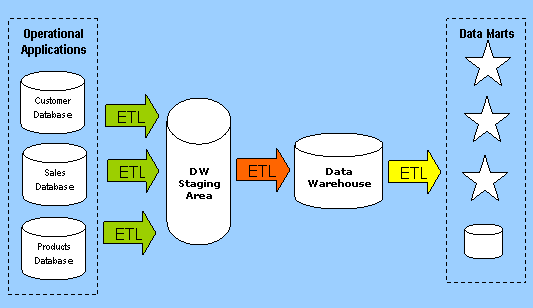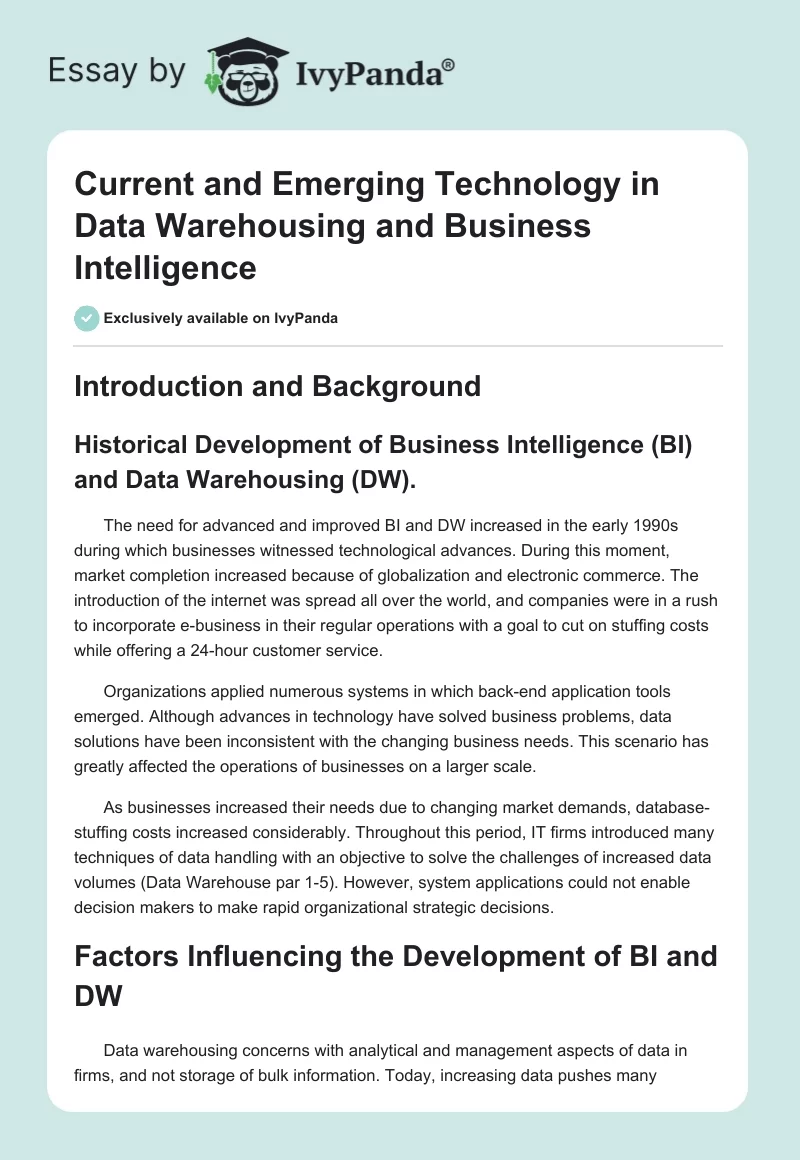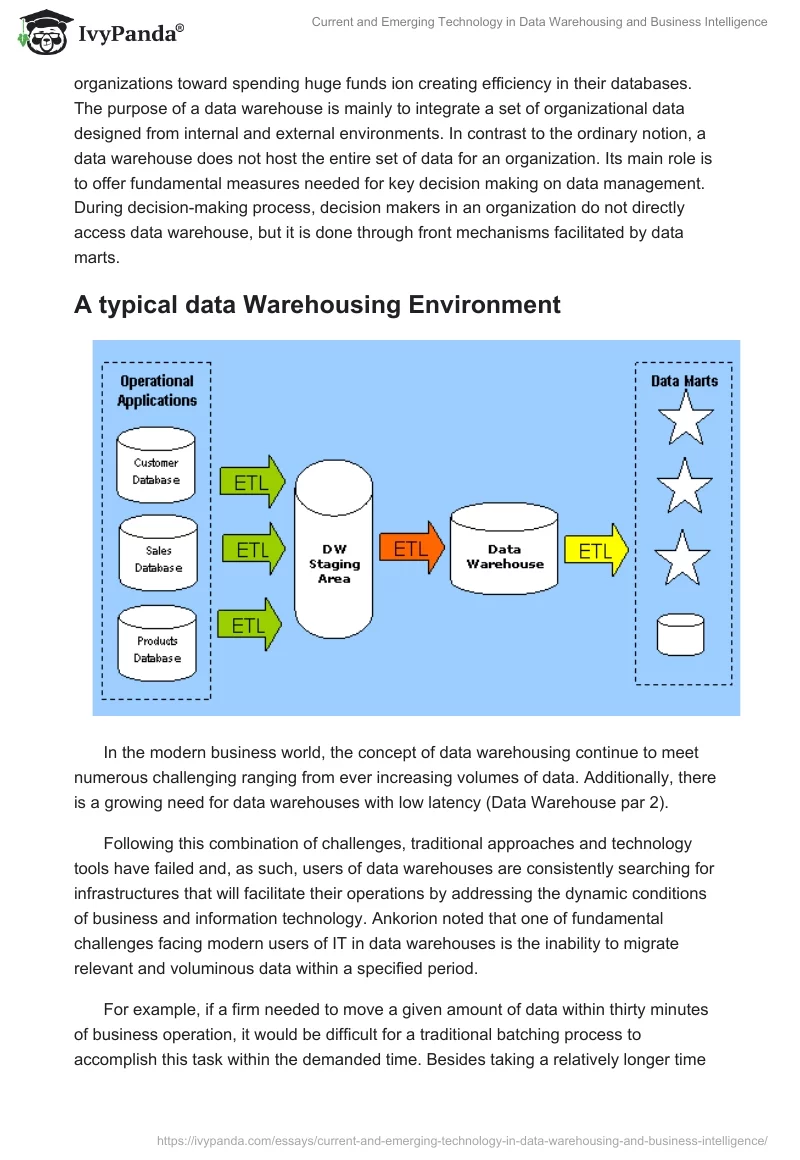Introduction and Background
The need for advanced and improved BI and DW increased in the early 1990s, during which businesses witnessed technological advances. At this moment, market competition increased because of globalization and electronic commerce. The introduction of the Internet spread worldwide, and companies were rushing to incorporate e-business in their regular operations to cut staffing costs while offering 24-hour customer service.
Organizations applied numerous systems in which back-end application tools emerged. Although technological advances have solved business problems, data solutions have been inconsistent with the changing business needs. This scenario has greatly affected the operations of businesses on a larger scale.
As businesses increased their needs due to changing market demands, database stuffing costs increased considerably. Throughout this period, IT firms introduced many techniques of data handling with an objective to solve the challenges of increased data volumes (Data Warehouse par 1-5). However, system applications could not enable decision-makers to make rapid organizational strategic decisions.
Factors Influencing the Development of BI and DW
Data warehousing concerns the analytical and management aspects of data in firms, and not the storage of bulk information. Today, increasing data pushes many organizations toward spending huge amounts of funds to create efficiency in their databases. The purpose of a data warehouse is mainly to integrate a set of organizational data designed from internal and external environments. In contrast to the ordinary notion, a data warehouse does not host the entire set of data for an organization. Its main role is to offer fundamental measures needed for key decision-making regarding data management. During the decision-making process, decision-makers in an organization do not directly access the data warehouse, but it is done through front mechanisms facilitated by data marts.
A typical data Warehousing Environment

In the modern business world, the concept of data warehousing continue to meet numerous challenging ranging from ever increasing volumes of data. Additionally, there is a growing need for data warehouses with low latency (Data Warehouse par 2).
Following this combination of challenges, traditional approaches and technology tools have failed and, as such, users of data warehouses are consistently searching for infrastructures that will facilitate their operations by addressing the dynamic conditions of business and information technology. Ankorion noted that one of fundamental challenges facing modern users of IT in data warehouses is the inability to migrate relevant and voluminous data within a specified period.
For example, if a firm needed to move a given amount of data within thirty minutes of business operation, it would be difficult for a traditional batching process to accomplish this task within the demanded time. Besides taking a relatively longer time that required, traditional batching technology creates negative impact on the operations during the loading process. Relying on this scenario, there is need for mechanisms to address challenges facing the implementation of contemporary strategic information management.
Business Intelligence (BI) refers to approaches and techniques applied by organizations to make strategic business decisions. Its main purpose is to cushion business technologies, which emphasize business goals to facilitate performance. In the recent years, many organizations have achieved success through investing huge funds in the development of robust BI and data warehousing processes. Emphasis on these two concepts revolves around a belief that accurate and effective access to information about services and customers offers a crucial basis for business success.
Today, businesses are striving to align themselves to the changing needs of data warehousing. Gartner, lnc notes that senior managerial executives and chief information officers (CIOs) need to acquaint themselves with the changing trends in the context of data warehousing. The kind of technological applications needed must be in line with the demands of cost-benefit analysis in order to deliver value to businesses in the twenty first century (Madhu par 7).
In the contemporary business world, data warehouses remain to be fundamental elements of the information technology (Madhu par 7). The increased need for setting up a robust and exclusive data infrastructures is a response to the changing needs for business intelligence (BI). The technological business world is growing at a faster rate and as such, there is need for a flexible, dynamic, and optimal data designs to enable business to deal with their information and security gaps.
The emerging trends din business enterprises inevitably declares data warehouses as one of the critical components of business information relay. In a report delivered by Madhu, he suggested that businesses and individuals would need information about the changing practices and consumer trends in order to develop strategies geared toward blending technology with current business solutions (par 5).
This information will assist firms, through warehouse authorities and CIOs to safeguard business operations against budget waste. In this paper, nine trends in warehousing and data management are critical in the next five years.
Grid Computing
Most organizations that utilize IT infrastructure have shifted toward implementation of grid computerization in their data warehousing mechanisms. The application of grid technology has enabled firms to develop databases with speed to maximize their performance. A grid refers to a set of servers linked to high-speed network, which integrates data to enable sharing among many separate departments or users. Since a single access mechanism is designed using a grid mechanism, users of this technology saves on costs and human resources. The figure below shows a typical computerization using grid.
Fig: typical computerization using grid

Data warehousing involves pooling of data from different parts of an organization. In order to make strategic and tactful business decisions, users retrieve these set of data via queries. Grinds help in scaling of data to improve the overall performance of data systems. The application of grids ensures reliability. Since it involves many servers, failure of one server may not lead to a fatal business breakdown.
Currently, organizations have begun to integrate grids with Data warehousing tools with a view to reduce transaction time, as well as operational costs. An example of ETL that has applied this technology is Informatica. In their production activities, oracle has utilized this form of technology in management of their processes. Many benefits accrue from utilization of grid computing in DW and BI processes. The major benefit is harnessing of underutilized capital and human resources in business enterprises while providing efficient and reliable data warehousing service.
Trends in Data warehousing
Optimization of data warehouse and performance.
Storage and management of data continue to face many challenges in many organizations (Nine Key Data Warehousing Trends par 5). Studies reveal that although firms have achieved effective systems in data handling, there are noticeable challenges in optimization of these systems in order to reap optimum benefits. Because of this emerging challenge, data management has tended to improve the functionality of data warehouses.
Many organizations have focused their attention on dealing with gaps in warehouses through data compression as viable strategies. On the other hand, data warehouse venting companies have emphasized the need for differentiated products in response to claims of non-performance.
Introduction and Usage of In-Memory Database Management systems (DBMSs).
Due to the merging need for real time access to warehouse data, data handling has taken this issue with a lot of keenness in order to business demands. Additionally, data sharing among various subsidiaries of the same companies has attracted huge interest among vendors. To address this information and technology needs, vendors have resorted to development of in-memory DBMS (IMDBMS) that have the capacity to relay fast responses to queries in real time.
Technology experts have predicted that in the near future, traditional approaches to data warehouses will need to adapt to the new technological needs fueled by market changes (Nine Key Data Warehousing Trends par 5). Both vendors and firms will require to adjust to new and advanced in-memory DBMS. Research suggests that application of IMDBMSs will help offer solutions to challenges of business intelligence. In return, solutions to BI problems will leverage firms through development of super-products that will become the focus of major vendors.
Use of Open-source Database Management Systems (OSDBMS) in data warehouses.
Currently, businesses and other firms have not emphasized the use of OSDBMS in their operations. Studies show that application of ODBMS has received mild response due to the usage of traditional approaches in data handling. A survey by Garter reveals that firms that have adopted these mechanisms have benefited both in real cost as well as efficiency (Nine Key Data Warehousing Trends par 4). Although the use of this category of technology requires manual system support, it offers best optimization solutions to data warehouses.
Need and use of Data marts
Data marts refer to an analytic data application usually handled by fewer users as compared to data warehousing. The technology is a revised information technology designed to optimize the performance of data warehouse. As it was mentioned, one of the major challenges facing organizations is the inability to generate maximum benefits from their existing systems. To leverage companies from this problem, data marts work to offload data warehouses in order to gain high performance.
Therefore, data marts act as middle partners that create efficiency and effective performance of data warehousing. Based on the emerging difficulties in upgrading data warehouses, data vending firms have rejuvenated their efforts in providing instant solutions to existing IT infrastructures through application of data marts.
Drivers influencing development of Data Warehousing/BI
Need for single-ended truth.
It is important to note that inconsistent and obsolete information does not provide a basis for proper and strategic decisions. Businesses have developed need to consolidate their BI data to enable tactful decision-making process. Companies dealing with data warehouses help businesses to design a single-ended or version that incorporates all data with accuracy and reliability.
The competitive business has pushed firms to develop viable strategic frameworks capable of informing the management of the best decisions. Strategic positioning requires establishment of a well-grounded information base to facilitate this process. Therefore, the need for one-stop data warehouse and business intelligence has necessitated the need for accurate and effective DW and BI.
Dynamic Information Needs
It is difficult for many businesses to accurately forecast or predict their future needs in respect of information. Many system applications have proven to be rigid with no capacity to change with the dynamic information needs. To move alongside changes in market demands, businesses require flexible information systems capable of analyzing dynamics of business environment.
To help address this need, business have developed a desire for data warehousing tools that designed to offer flexibility in terms of decision making by the management and chief information officers.
Need for good customer care
Customers are the backbone of the progress of any business and as such, due consideration must be given when designing information systems that facilitate transactions. Research has indicated that about 10% of the customers are responsible for 90% of profits. Therefore, businesses have focused on the need to offer excellent customer service in order to gain market loyalty.
Studies show that data warehousing and its application tools has the capacity to identify best or potential customers. This trend has made businesses to develop impetus for swift and efficient data warehousing tools and business intelligence systems to help align themselves to the market dynamics. Studies show that companies that have applied DW and BI in their operations have reaped maximally. Benefits have included reduced costs of transaction, distribution and, advertising.
Supply chain management.
The growing competition in the business world has necessitated the need for supply chain systems capable of addressing distribution challenges within minimum period. This need calls for partnership with supply chains that have the technological capacity to deliver on promises of the customer.
To help achieve this objective, firms have resorted to investing in data tools that will help them meet customer needs within real time. Traditionally, distributors of products delivered at their own comfort. Contrary to this case, businesses are fighting to gain the largest market share and as such, focus has shifted toward ensuring reliability.
Need for Updated and Accurate information.
Today, businesses thrive under competitive market environments that require from them to make quick decisions. When faced with problems, businesses expect to identify the contributing factors, identify weaknesses, and give responsive solutions to the underlying circumstances. As such, contingent decision plans must be set up in order to enable businesses to leverage themselves from challenges of lacking instant solutions (Data Warehouse par 5).
Therefore, firms need to analyze their internal and external business environments with a goal to identify strengths, opportunities, weaknesses, and threats. This process needs business to access up-to-date data to respond to challenges, as well as utilize opportunities available to them.
Technical Factors influencing development of Data Warehousing/BI
Need for Simple systems.
Systems responsible for data handling are generally complicated. There is a growing need for simple, but efficient data management system to help businesses respond to the needs of market environment. Complex systems are costly since they require much time to work on to deliver results.
For example, a complex system would take an average user a longer time to understand or to initiate a transaction. A reporting environment would need a simple, yet efficient IT infrastructure to enable faster production of relevant business reports to enable proper decision-making.
Data warehousing provides an IT platform that generates simple queries when accessing information necessary for business progress (Nine Key Data Warehousing Trends par 4). Data warehousing has inherent ability to simplify this tasks because of its simplistic nature. Since business have been in dire need of such kind of IT tools, their development has been fast tracked to help them meet their need for simple systems.
Evolution of Application systems.
Technology is one of the fastest growing and changing phenomena in the world. Similarly, businesses are inevitably dynamic because of their fragile market environments. Because of this, businesses are continuously in need of support to meet their ever-changing market demands. Changes in business needs do so at faster rate than the growth in returns. As such, there is a need to cut on information costs while remaining relevant to the new information.
The changing business needs that have required an evolving application system resulted in a trend to design a data warehousing applications that would render businesses updated. Data warehouses have developed out of the inability of businesses to offer reliable and inexpensive solutions to their dynamic problems.
Conclusion
Technological advances continue to evolve at a high rate with every passing minute. The information systems have played huge roles in the development of business themes, which have facilitated progress. Today, there is a growing need for new information in all spheres of life.
The dynamics of business environment has necessitated businesses to seek information infrastructures to inform managers of the best decision practices that would help to safeguard the business against potential threats while, at the same time, taking advantage of the opportunities.
Developments witnessed in DMBMS are instrumental in ensuring that business intelligence and data warehousing work to benefit organizations.
Today, competition has become the order of the day in the business world. To enable businesses to make up for the changing information needs and reduced costs, IT firms continue to experience pressure in order to yield infrastructure that has the ability to meet customer needs. While designing data warehouse, It experts should be able to examine multiple factors that unite to deliver a DW with ability to meet the demands of the business world as well as cut down on the designing cost.
An examination of the changing fundamental indicators is critical in establishing solutions that would take businesses to the next level of competition. As data increases in business data stores, It designers should be ready to adapt to changing environment to enable organizations make tactful decisions relevant to improving business performance. To achieve this task, they must address issues related to scalability, accuracy, flexibility of data warehousing tools.
Various factors have contributed to the emergence and rapid development of IT infrastructure in terms of DW and BI. Since business intelligence relies heavily on the robustness of information systems adopted by particular business, it is imperative to design DBMS capable of providing a framework upon which business intelligence work.
There are two categories of drivers that account for the emergence and development of DW and BI. These factors include technical and business drivers. Technical drivers have cooperated with the demands of the business environment to ensure that efficient and robust DBMSs.
Business factors consist of all market factors causing a reaction from CIOs and managers in order to meet business objectives. Both vendors and firms will require to adjust to new and advanced in-memory DBMS. Application of IMDBMSs will help to offer solutions to challenges of business intelligence. In return, solutions to BI problems will leverage firms through development of super-products that will become the focus of major vendors.
Works Cited
“Data Warehouse.” Data-Warehouse. Net. Web.
Madhu, Zode. “Grids in Data Warehousing.” TDAN.com, 1 Jan. 2009. Web.
“Nine Key Data Warehousing Trends for the CIO in 2011 and 2012.” ITBusinessEdge. 1 Jan. 2009. Web.


